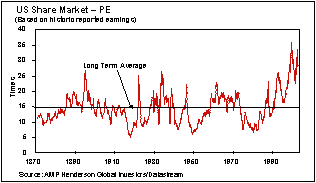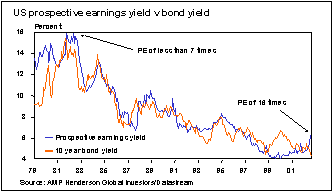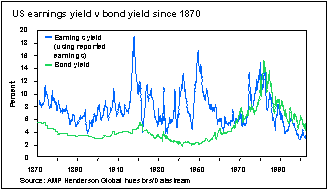There appear to be two approaches in assessing US shares. Bearish assessments focus on absolute valuation measures, comparing share prices to fundamentals such as earnings, dividends or the book value. Bullish assessments tend to use relative value measures which allow for the current low level of interest rates and bond yields.
Absolutely overvalued….
Variations on this approach allow for the current level of write-downs and thus focus on operating earnings.
Others allow for the PE on US shares being inflated by a cyclical slump in US earnings and thus focus on trend or forward earnings. However, these variations still put the PE above its long-term average, suggesting US shares are
expensive.
There are several problems with these approaches. First, such measures often deviate from their long-term averages for extended periods (up to 20 years), making them less useful as a short-term valuation tool. Measures like the PE tend to value the US market as expensive in the early/mid 1990s when the Dow Jones index was below 4000. They
are best seen as a long-term guide only; when high (eg. late 1960s and more recently) they warn of a long future period of low returns, when low (eg. late 1970s/early 1980s) they warn of future high returns.
Second, their interpretation is made difficult by structural changes, eg. current low inflation can in large part explain high US PEs. High inflation creates earnings uncertainty and reduces the quality of reported earnings (as companies tend to under-allow for depreciation).
Hence, high inflation periods are associated with low PEs and vice versa - as is currently the case.
Third, for most investors the issue is not whether the PE of the market is high relative to its long-term history,
but rather whether shares look cheap compared to other investments.
Fourth, a return to a PE of 15 or below in the absence of rising inflation or sustained deflation would take the
prospective return premium of US shares over bonds to implausibly high levels. We would need a serious and sustained economic deterioration to justify such a
move.
...but relatively cheap
A similar picture is seen comparing cash returns with dividend yield. Allowing for share buy backs, the dividend
yield on US shares is around 2.5% - above the available return on US money market accounts (generally below 1.5%).
Thus relative valuation indicators conclude that as long as US inflation, cash returns and bond yields
remain low, the market will continue to trade on PE multiples above historic long-term averages. The current level of cash returns and bond yields suggest
that the US market is extremely cheap.
This approach also has deficiencies. First, the relationship observed between bond yields and earnings yields is a phenomenon of the past 30 years - prior to this shares were mainly held for dividends rather than capital growth (see chart below). The risk is that after
the experience of the past few years, investors may demand more certainty and insist on higher dividend yields.
Second, there is no theoretical reason why the earnings yield should move around the bond yield. Such a relationship assumes a constant long-term earnings growth rate, share risk premium and ratio of dividends to earnings.
Thirdly, current bond yields of near 4% in the US are not necessarily sustainable. If bond yields rise (prices
fall), some of the value apparent in US shares will vanish.
Fourthly, the relationship could give misleading signals when inflation and bond yields are at very low levels.
We are then flirting with deflation, which could be bad for shares if earnings are threatened.
Despite these shortcomings, the bond earnings yield
approach has been a good indicator since the late 1970s.
So what is
the answer? ·
The high level of US PEs provides a
warning that long-term returns from US stocks will be constrained.
Nevertheless, in the absence of a return to 1970s inflation or a deflationary
shock, it is hard to see the PE on historic earnings falling back to pre 1960s
norms. · In valuing shares investors can't ignore
the yield or likely return on other assets. The bond earnings yield approach
may overstate the attractive valuation of US shares. However, as shares are
extremely cheap versus bonds on this measure, there is still likely to be more
upside in US stocks on a six to 12 month horizon. Source:
AMP Henderson Global Investors, Investment Insights Newsletter, August 27, 2002 Special Offers © Copyright 1997-2025 Tarawera Publishing Ltd. All Rights Reserved



Note: reported earnings have been used to
construct earnings yield as data for prospective earnings is not available
before the late 1970s.
« The active/passive debate surfaces - again King builds an empire » Commenting is closed

www.GoodReturns.co.nz